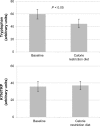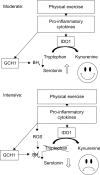Diet Versus Exercise in Weight Loss and Maintenance: Focus on Tryptophan
- PMID: 27199566
- PMCID: PMC4864009
- DOI: 10.4137/IJTR.S33385
Diet Versus Exercise in Weight Loss and Maintenance: Focus on Tryptophan
Abstract
An association between mood disturbance, the inability to lose or to stop gaining weight, and a craving for carbohydrates is manifested by many people who are overweight or are becoming so. In a recent study, we observed that low-calorie weight loss diet lowered not only levels of leptin but also levels of essential amino acid tryptophan (TRP) significantly. The disturbed metabolism of TRP might affect biosynthesis of serotonin and could thereby increase the susceptibility for mood disturbances and carbohydrate craving, increasing the cessation probability of weight reduction programs. Alternatively, moderate physical exercise - a potent stimulus to modulate (reduce/normalize) proinflammatory cytokines, which may affect TRP levels - could be helpful in improving mood status and preventing uncontrolled weight gain. In contrast, excessive physical exercise may induce breakdown of TRP when proinflammatory cascades together with TRP-degrading enzyme indoleamine 2,3-dioxygenase-1 are stimulated, which may lead to neuropsychiatric symptoms such as fatigue and low mood.
Keywords: diet; exercise; mood; tryptophan; weight loss maintenance.
Figures


Similar articles
-
Effects of a caloric restriction weight loss diet on tryptophan metabolism and inflammatory biomarkers in overweight adults.Eur J Nutr. 2015 Feb;54(1):101-7. doi: 10.1007/s00394-014-0690-3. Epub 2014 Apr 1. Eur J Nutr. 2015. PMID: 24687684 Clinical Trial.
-
[Impact of interferon alpha immunotherapy on tryptophan metabolism in patients with chronic hepatitis C. Results of a pilot studies on ten patients].Encephale. 2009 Oct;35(5):477-83. doi: 10.1016/j.encep.2007.09.007. Epub 2008 Jun 12. Encephale. 2009. PMID: 19853722 French.
-
Organ Co-Relationship in Tryptophan Metabolism and Factors That Govern the Biosynthesis of Nicotinamide from Tryptophan.J Nutr Sci Vitaminol (Tokyo). 2018;64(2):90-98. doi: 10.3177/jnsv.64.90. J Nutr Sci Vitaminol (Tokyo). 2018. PMID: 29710037 Review.
-
The effect of weight management interventions that include a diet component on weight-related outcomes in pregnant and postpartum women: a systematic review protocol.JBI Database System Rev Implement Rep. 2015 Jan;13(1):88-98. doi: 10.11124/jbisrir-2015-1812. JBI Database System Rev Implement Rep. 2015. PMID: 26447010
-
Tryptophan availability for kynurenine pathway metabolism across the life span: Control mechanisms and focus on aging, exercise, diet and nutritional supplements.Neuropharmacology. 2017 Jan;112(Pt B):248-263. doi: 10.1016/j.neuropharm.2015.11.015. Epub 2015 Nov 23. Neuropharmacology. 2017. PMID: 26617070 Review.
Cited by
-
Metabolic effects of physical exercise on zebrafish (Danio rerio) fed a high-fat diet.J Comp Physiol B. 2024 Dec;194(6):793-804. doi: 10.1007/s00360-024-01577-x. Epub 2024 Jul 31. J Comp Physiol B. 2024. PMID: 39085644
-
Weight Maintenance after Dietary Weight Loss: Systematic Review and Meta-Analysis on the Effectiveness of Behavioural Intensive Intervention.Nutrients. 2022 Mar 16;14(6):1259. doi: 10.3390/nu14061259. Nutrients. 2022. PMID: 35334917 Free PMC article.
-
Brain-Periphery Interactions in Huntington's Disease: Mediators and Lifestyle Interventions.Int J Mol Sci. 2024 Apr 25;25(9):4696. doi: 10.3390/ijms25094696. Int J Mol Sci. 2024. PMID: 38731912 Free PMC article. Review.
-
A New Tool for Rapid Assessment of Acute Exercise-Induced Fatigue.Front Hum Neurosci. 2022 Mar 16;16:856432. doi: 10.3389/fnhum.2022.856432. eCollection 2022. Front Hum Neurosci. 2022. PMID: 35370582 Free PMC article.
-
Role of Dietary Protein and Muscular Fitness on Longevity and Aging.Aging Dis. 2018 Feb 1;9(1):119-132. doi: 10.14336/AD.2017.0202. eCollection 2018 Feb. Aging Dis. 2018. PMID: 29392087 Free PMC article. Review.
References
-
- World Health Organization Obesity and overweight. Fact Sheet No. 311. 2014. [Accessed January 2016]. Available at: http://www.who.int/mediacentre/factsheets/fs311/en/
-
- Gustafson D, Lissner L, Bengtsson C, Björkelund C, Skoog I. A 24-year followup of body mass index and cerebral atrophy. Neurology. 2004;63:1876–81. - PubMed
-
- Kaur S, Gonzales MM, Strasser B, et al. Central adiposity and cortical thickness in midlife. Psychosom Med. 2015;77:671–8. - PubMed
-
- Whitmer RA, Gunderson EP, Quesenberry CP, Jr, Zhou J, Yaffe K. Body mass index in midlife and risk of Alzheimer disease and vascular dementia. Curr Alzheimer Res. 2007;4:103–9. - PubMed
Publication types
LinkOut - more resources
Full Text Sources
Other Literature Sources
Research Materials

